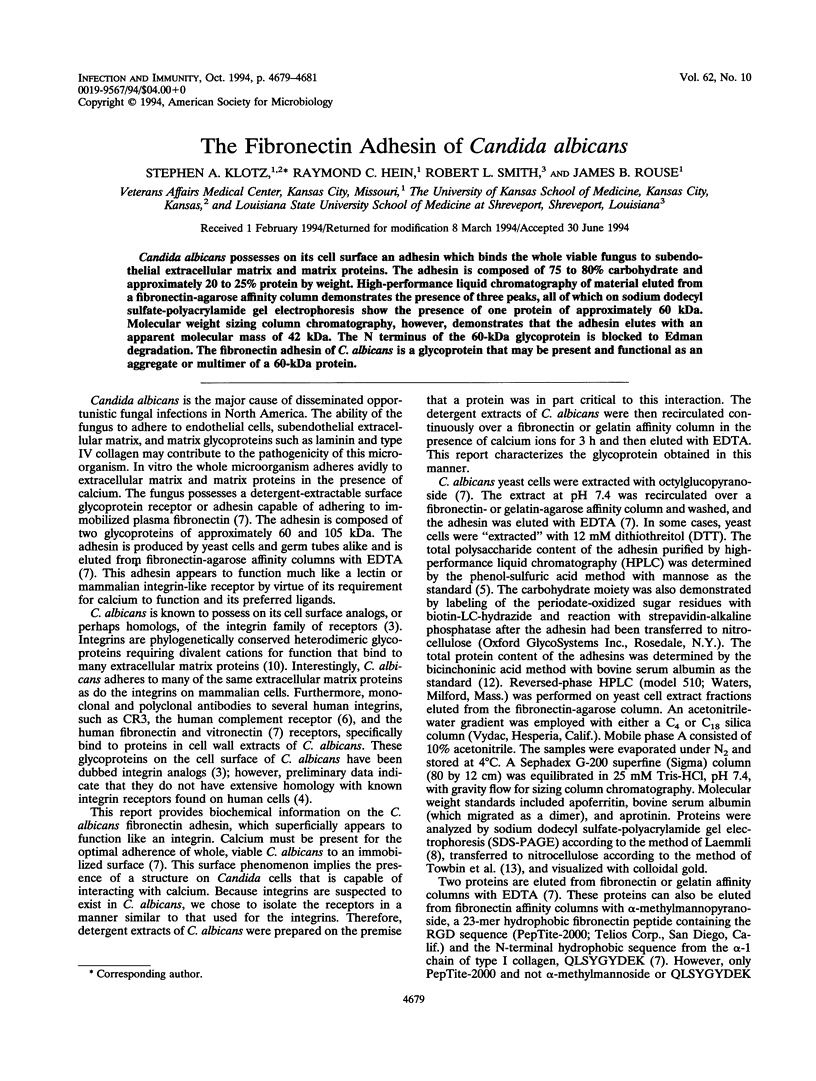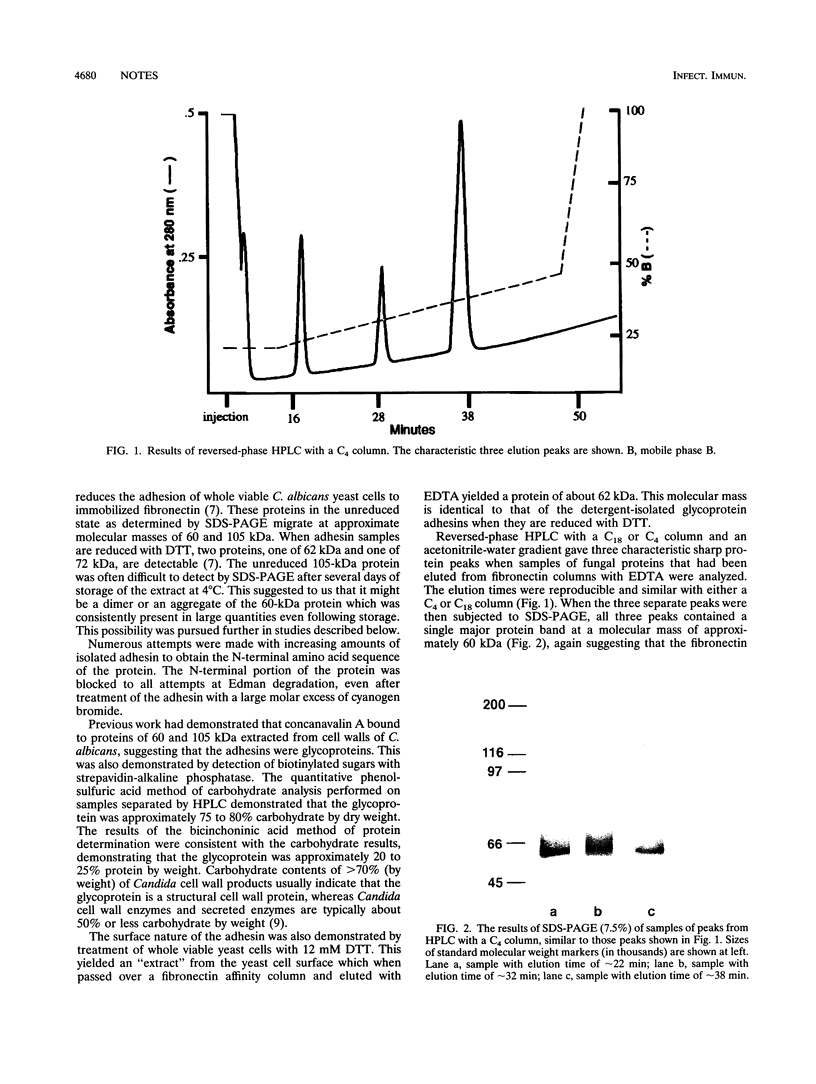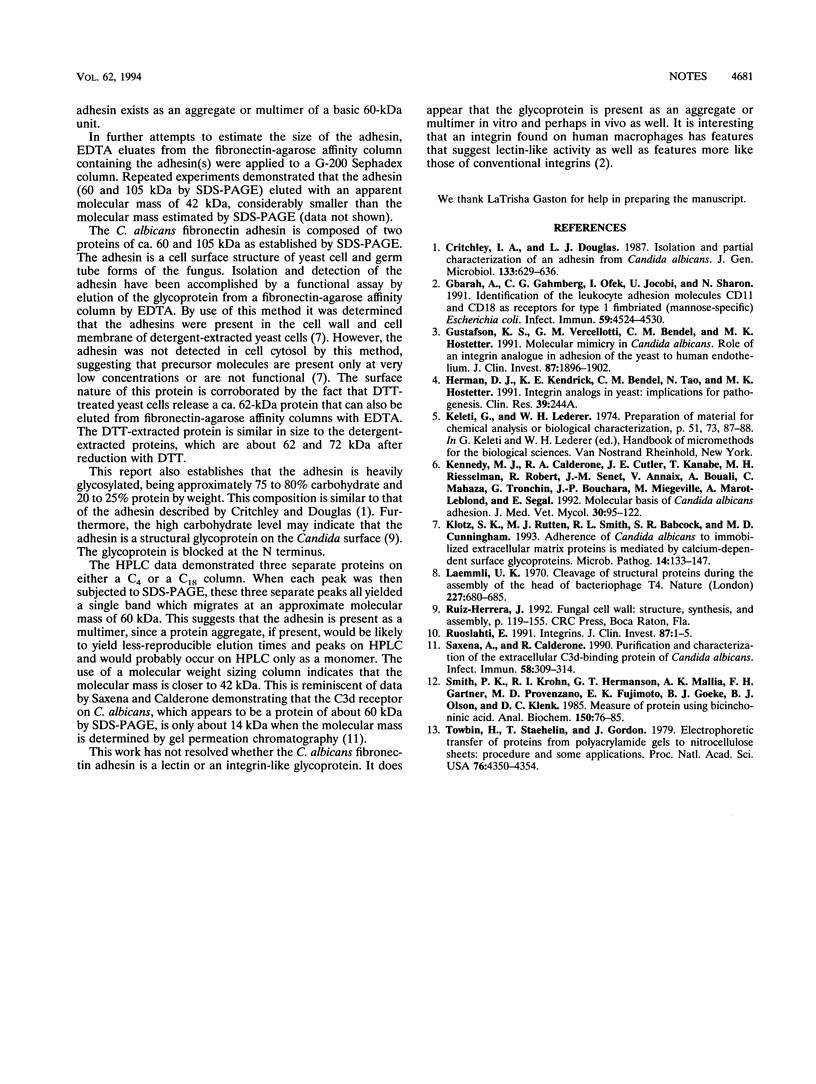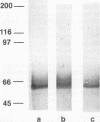Abstract
Candida albicans possesses on its cell surface an adhesin which binds the whole viable fungus to subendothelial extracellular matrix and matrix proteins. The adhesin is composed of 75 to 80% carbohydrate and approximately 20 to 25% protein by weight. High-performance liquid chromatography of material eluted from a fibronectin-agarose affinity column demonstrates the presence of three peaks, all of which on sodium dodecyl sulfate-polyacrylamide gel electrophoresis show the presence of one protein of approximately 60 kDa. Molecular weight sizing column chromatography, however, demonstrates that the adhesin elutes with an apparent molecular mass of 42 kDa. The N terminus of the 60-kDa glycoprotein is blocked to Edman degradation. The fibronectin adhesin of C. albicans is a glycoprotein that may be present and functional as an aggregate or multimer of a 60-kDa protein.
Full text
PDF


Images in this article
Selected References
These references are in PubMed. This may not be the complete list of references from this article.
- Critchley I. A., Douglas L. J. Isolation and partial characterization of an adhesin from Candida albicans. J Gen Microbiol. 1987 Mar;133(3):629–636. doi: 10.1099/00221287-133-3-629. [DOI] [PubMed] [Google Scholar]
- Gbarah A., Gahmberg C. G., Ofek I., Jacobi U., Sharon N. Identification of the leukocyte adhesion molecules CD11 and CD18 as receptors for type 1-fimbriated (mannose-specific) Escherichia coli. Infect Immun. 1991 Dec;59(12):4524–4530. doi: 10.1128/iai.59.12.4524-4530.1991. [DOI] [PMC free article] [PubMed] [Google Scholar]
- Gustafson K. S., Vercellotti G. M., Bendel C. M., Hostetter M. K. Molecular mimicry in Candida albicans. Role of an integrin analogue in adhesion of the yeast to human endothelium. J Clin Invest. 1991 Jun;87(6):1896–1902. doi: 10.1172/JCI115214. [DOI] [PMC free article] [PubMed] [Google Scholar]
- Kennedy M. J., Calderone R. A., Cutler J. E., Kanabe T., Riesselman M. H., Robert R., Senet J. M., Annaix V., Bouali A., Mahaza C. Molecular basis of Candida albicans adhesion. J Med Vet Mycol. 1992;30 (Suppl 1):95–122. [PubMed] [Google Scholar]
- Klotz S. A., Rutten M. J., Smith R. L., Babcock S. R., Cunningham M. D. Adherence of Candida albicans to immobilized extracellular matrix proteins is mediated by calcium-dependent surface glycoproteins. Microb Pathog. 1993 Feb;14(2):133–147. doi: 10.1006/mpat.1993.1014. [DOI] [PubMed] [Google Scholar]
- Laemmli U. K. Cleavage of structural proteins during the assembly of the head of bacteriophage T4. Nature. 1970 Aug 15;227(5259):680–685. doi: 10.1038/227680a0. [DOI] [PubMed] [Google Scholar]
- Ruoslahti E. Integrins. J Clin Invest. 1991 Jan;87(1):1–5. doi: 10.1172/JCI114957. [DOI] [PMC free article] [PubMed] [Google Scholar]
- Saxena A., Calderone R. Purification and characterization of the extracellular C3d-binding protein of Candida albicans. Infect Immun. 1990 Feb;58(2):309–314. doi: 10.1128/iai.58.2.309-314.1990. [DOI] [PMC free article] [PubMed] [Google Scholar]
- Smith P. K., Krohn R. I., Hermanson G. T., Mallia A. K., Gartner F. H., Provenzano M. D., Fujimoto E. K., Goeke N. M., Olson B. J., Klenk D. C. Measurement of protein using bicinchoninic acid. Anal Biochem. 1985 Oct;150(1):76–85. doi: 10.1016/0003-2697(85)90442-7. [DOI] [PubMed] [Google Scholar]
- Towbin H., Staehelin T., Gordon J. Electrophoretic transfer of proteins from polyacrylamide gels to nitrocellulose sheets: procedure and some applications. Proc Natl Acad Sci U S A. 1979 Sep;76(9):4350–4354. doi: 10.1073/pnas.76.9.4350. [DOI] [PMC free article] [PubMed] [Google Scholar]



